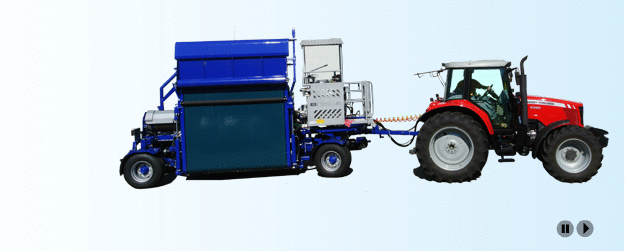Silage bagger EB 310 LG
Silage bagger EB 310 LG is currently the most demanded machine from all offered models. It is popular namely thanks to several basic characteristics, such as its transport speed and stability during transport, high power and even filling of the bag, speed and comfort during the machine preparation for bagging and last but not least, massive structure and technical design.
Parameters of silage bagger EB 310 LG
The user can choose from two sizes of tunnels - a smaller combination of 2.4 + 2.7 m tunnels or larger with 2.7 + 3.0 m tunnels The tunnels are extended to eliminate bumps in the bag. Haylage press EB 310 LG is highly technologically advanced and uses state-of-the-art accessories. The hydraulic system is adapted for LOAD SENSING with tractor fuel saving.
EB 310 LG - Technical data sheet
From road directly to the bag
The machine is connected to the tractor on the side of the control platform. Thanks to the new QUICK system the tractor is permanently connected to the machine, both during transport and during bagging, without having to disconnect the tractor during preparation of the machine for bagging. This system makes the bagging preparation significantly faster and easier, which is mostly appreciated by service companies that change the bag location practically every day Backing up to the bag is fast and easy by a skilled tractor driver who gradually drives to the bag and turns the machine to an angle of 90 ° towards the tractor. Front and rear wheels are turned remotely using a remote control. The speed of turning is controlled proportionally on the joystick. When the machine is turned exactly at an angle of 90 °, a signalization light will turn on and the operating staff may secure the machine by a stub - also on the remote control.
Comfortable control and accessories of this silage bagger
As already mentioned above, auxiliary functions are controlled via a remote control and the machine can be therefore operated by only 1 person. The process is also made easier by hydraulic elements - the operator can use a hydraulic crane to fix the bag, lift bars hydraulically when connecting the machine to the tractor, at the end of the bag the operator can clean the tunnel by a hydraulically sliding bottom below the rotor - the remaining forage falls into the bag. The only mechanically controlled elements are tilting of the feeding table, moving of the conveyor belt on the table and tedding shafts. The last two functions are controlled proportionally, the direction and speed of moving is selected by the operator by turning the lever on the distributor with friction lock. The control platform on the machine is spacious and is located in an elevated position to allow view of the filling space. Sideplates of the feeding table have higher sides to prevent falling of forage outside the filling table area. Rubber at the front of the table prevents falling of forage in front of the table.
Grass haylage
The quality of pressed haylage in the bag is ensured by a specially constructed rotor with irregular location of fingers. The rotor regularly presses forage into the pressing chamber - a tunnel, from which all air is pushed out. The machine is capable of pressing all types of grass, clover grass, snail clover and various mixtures. In order to ensure high quality it is necessary to follow the correct technological procedure of harvest, namely make sure the chopped straw has the correct length and optimum dry matter is observed. The machine can also be used for bagging of haylage after self-collecting machines, but it is necessary to ensure the machine knives are sharp. Generally speaking, the longer and drier chopped straw is, the harder it is to press it in the bag, which results in lower quality of haylage in the bag. Disc brakes are used to ensure correct pressing of haylage. The brakes hold the gate at the end of the bag through steel ropes. EB 310 LG has 4 large brake straps that ensure gradual winding of ropes without jumps and shocks.
Maize silage
Storage of maize silage is easier in comparison with grass haylage. Maize is loose and the bag is usually more regular. At the same time, lower braking pressures are used. If good terrain is selected for bagging, the machine may be braked without the rear gate. For internal braking, where a rope loop of a different length goes through the bag, additional braking is provided by wheels via the air system. The braking degree is regulated on the control platform. This system allows creation of bags larger than 75 m, usually 90 m. The internal braking is also most comfortable as it does not require steel ropes, binding of ropes at the end of the bag and moving of the gate from bag to bag. It has been confirmed by the users that daily output with internal braking is 30 % higher than bagging with a gate.
Sugar beet slices, spent grains and other by-products
There has been a significant demand for storage of by-products in the last three years. Products such as sugar beet slices and spent grains are a rich supplement to forage. Bagging of these products requires certain attention, especially for low content of dry matter. In such situations, smaller bag diameters (2.7 or 2.4 m) are selected. The output of these materials is high and pressing in the bag does not require high pressure. Bagging of spent grain is done practically without pressure; sometimes it is necessary to travel with the tractor.
CCM – mashed maize grain, cereals
The machine can also be used to store mashed grains or whole grains. Smaller diameters of 2.7 or 2.4 m are used for these products.


























